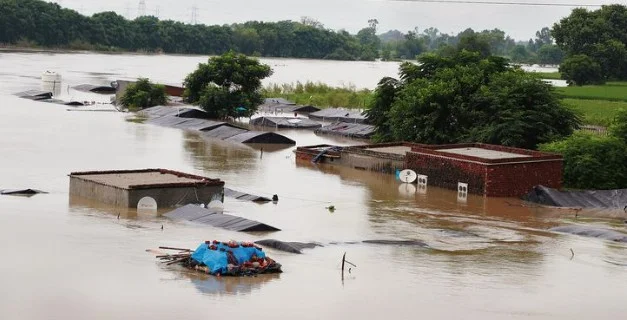CHANDIGARH, September 3:— All 23 of Punjab’s districts have been declared flood-hit, with the state recording 30 deaths and more than 350,000 people affected, according to official data.
The crisis has prompted officials to order a war-footing response from various departments. Public Works, Water Resources, and Power departments have been instructed to immediately begin repairs on critical infrastructure, while telecommunications operators have been told to ensure uninterrupted mobile and landline connectivity. Meanwhile, local officers are tasked with ensuring the smooth movement of people and essential services.
The floods have submerged standing crops on over 400,000 acres, and rescue teams have evacuated around 19,600 people from 1,400 affected villages. A total of 171 relief camps have been established, providing shelter to 5,167 people.
Punjab Governor Gulab Chand Kataria and Chief Minister Bhagwant Mann toured the affected areas on Tuesday to oversee the ongoing relief and rescue operations. Civil administration and specialized teams from the Army, Air Force, National Disaster Response Force (NDRF), and the Border Security Force (BSF) are on the ground, preparing for more heavy rainfall predicted for Wednesday and Thursday.
The surge in water levels is attributed to heavy rainfall in the upstream catchment areas of the Ravi and Beas rivers in Jammu and Kashmir and Himachal Pradesh. The water flow in the Ravi at the Ujh barrage dramatically increased from 7,474 cusecs in the morning to 52,341 cusecs by evening. Similarly, the Beas at Chakki Bank saw its flow increase from 1,910 cusecs to 8,400 cusecs.
Reservoirs are also nearing critical levels. The water level in the Pong Dam, on the Beas, was recorded at 1,391 feet, slightly above its danger mark of 1,390 feet. The Bhakra Dam reservoir neared its danger mark of 1,680 feet, with a recorded level of 1,677.32 feet. The Ranjit Sagar Dam, on the Ravi, recorded the highest inflow at 171,000 cusecs. Meanwhile, the flow of the Sutlej river at Ropar has slightly receded.

